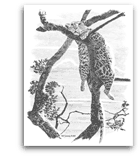LEOPARD
#LPD-500
Notecards
Also available in Notecard Assortment Packs #AST-512
& #AST-513
#LE-LPD-500 Limited Edition Print
After
gorging on an antelope, this leopard relaxes in a tree. The great
cat typically drags its prey into the branches to keep it away
from larcenous hyenas and jackals. Because the leopard often manages
to bag animals larger than itself, it thinks nothing of returning
to the tree several times for leftovers. Sometimes a leopard may
store several kills in a tree at the same time.
The
leopard has a strong appetite for hoofed animals, but in a pinch
it will settle for monkeys, small reptiles, dogs, insects, and
fruit. Once in a great while, some leopards even develop a taste
for man. In the Himalayan foothills, a leopard once killed at
least 125 people during an eight year period.
The
leopard is such an efficient hunter that it can afford to rest
as much as 20 hours a day. On the prowl, the leopard creeps very
quietly, its spotted body blending into the surrounding cover.
It usually remains undetected until the final rush.
Except
for the wolf and man, no other mammal has a natural range over
more of the earth than the leopard. This cat thrives in virtually
any African or Asian locale that offers sufficient food and cover,
including rain forests, deserts, wooded savanas and mountains.
Most
adult males weigh 100–130 pounds. Lions and tigers, which
may be four times larger, will kill a leopard if given the opportunity.
The
female gives birth to two or three young in a secluded den. The
helpless cubs, which weigh about a pound at birth, first open
their eyes after 10 days. By the time they leave their mother
16 to 24 months later, they can spot moving prey a mile away.
Text
© 1997 Terry White, Drawing © 1997 Bill Harrah.
|

Leopard
#LE-LPD-500
Limited Edition Print
Issue Date: 03/2002
Edition Size: 500
Image: 6.5” x 8.25”
Paper: 8.5” x 11”
Mat: 11” x 14”
$35.
View
matted print
|
|
Copyright
Notice
Drawings Copyright © 1992-2013 Bill Harrah, Wolf Run Studio (SM), All Rights
Reserved. Wolf Run Studio is a service mark of Bill Harrah and has been in continuous
use since 1992. All of the images on this website are in tangible form and are
fully copyrighted. Each has an invisible digital identification which is traceable
through the Digimarc Corporation. Viewers of the Wolf Run Studio website are
allowed to browse and print out images for personal, non-commercial use only.
You may not distribute copies of images or image files to anyone else for any
reason. Images may not be reproduced or used in any form or any manner, or displayed
on any website without the express written consent of Bill
Harrah.
Text Copyright
© 1992-2013
Terry White or
Dianne Harrah. Text on this website is used with permission from the authors.
Viewers of the Wolf Run Studio website are allowed to browse and print out text
for personal, non-commercial use only. Text may not be reproduced or used in any
form or any manner without the express written consent of the authors.
Information
Accuracy
The information for the written description of each animal has been carefully
researched by the authors and is believed to be accurate. New scientific observations,
however, could make some information out-of-date. If you are a professional
zoologist, and have new information that you are willing to share, please contact
Dianne Harrah .
|



